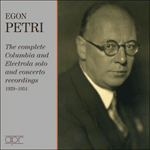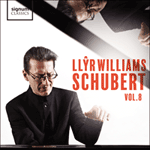
Welcome to Hyperion Records, a British classical label devoted to presenting high-quality recordings of music of all styles and from all periods from the twelfth century to the twenty-first.
Hyperion offers both CDs, and downloads in a number of formats. The site is also available in several languages.
Please use the dropdown buttons to set your preferred options, or use the checkbox to accept the defaults.

This is not the place to go too deeply into the history of the original Schubert cycle, D911, but it was composed in two bursts of creativity in 1827, to poems by the same Wilhelm Müller whose texts inform Die schöne Müllerin. There are those who argue that, by the time the second book of these songs was written, Schubert should have re-ordered them in line with the order of the original poems. David Owen Norris has also argued for re-ordering the Liszt transcriptions along similar lines. The cleverness of the modern compact disc player will allow the gentle listener to experiment at will, but here the transcriptions are given as Liszt published them, and they comprise numbers 1, 23, 22, 13, 4, 6, 5, 24, 19, 21, 18 and 17 of Schubert’s cycle. Liszt’s key structure is typically interesting: D minor, B flat major (Schubert has A major), G minor, E flat major, C minor, E minor (Schubert has F sharp minor), E major, A minor, A major, F major and D minor/D major/D minor. Like the Schwanengesang transcriptions, Liszt furnished alternative readings, but in this case only for five of the songs (see Volume 33).
Liszt begins his journey as does Schubert, with the uncannily imaginative walking song Gute Nacht (‘Goodnight’), eliminating the penultimate verse and treating the piece as a theme and variations. As so often, the poet’s theme is that of love rejected, and Liszt contributes with skilful word-painting in his choice of fragile textures to depict the Mondenschatten (‘shadow in the moonlight’) and the undisturbed dreams of the beloved being left behind. In Die Nebensonnen (‘Mock Suns’) Liszt takes Schubert’s song in one verse and extends it into a dramatic narrative that truly reflects the emotional compass of this prickly poem: the conceit of an optical illusion of three suns representing the poet’s failure in human relationships. Liszt treats Mut (‘Courage’) with appropriately festive decoration (and eliminates the reprise of the introduction at the coda), merrily facing with Müller and Schubert the world’s squalls.
In Die Post the poet has an involuntary leaping of the heart at the sound of the posthorn presaging mail from the town where he once had a true love, knowing that there will be no post for him. Liszt’s setting is straightforward, with one or two musical sighs added, and a splendid self-mocking clatter at the coda. Erstarrung (‘Numbness’) finds the poet in pain at his loss. Nature, like his heart, is frozen, but if it should melt, then so would his inner image of his love in his as-dead heart. Liszt deliberately begins tentatively, with the melody slightly displaced from the beat, but as the song’s anguish mounts he becomes forthright and impassioned. In Wasserflut (‘Floodwaters’) the poet speaks to the snow of the fate of his falling tears in a thaw: when the floodwaters pass his beloved’s house his tears will glow. Schubert sets this most introspectively, and Liszt follows him to the letter. Der Lindenbaum (‘The Linden Tree’) is the poet’s solace, his sheet-anchor in times good and bad, and finally a recollected place of peace. Liszt applies an astonishing armoury of delicate effects, especially with trills, to conjure both the rustling of the leaves and the tree’s innate tranquillity.
For those who know the song-cycle well, it comes as rather a surprise to encounter Der Leiermann (‘The Organ Grinder’) anywhere but at the end, where the poet’s disillusion becomes complete. But Liszt sees a good juxtaposition with the next song and treats this one as a simple introduction, moving without pause to the false attraction (so beautifully captured by both Schubert and Liszt) of Täuschung (‘Delusion’), in which the poet imagines briefly that a friendly light will lead him out of his cold wanderings into warmth and even into love. Das Wirtshaus (‘The Wayside Inn’) is really a graveyard, where the poet is ready to lie down, but his time is not come and he must move on. Liszt sustains the still slowness of Schubert’s masterpiece with a remarkable variety of textures, finally allowing himself tremolos and trills to underline the misery of rest denied.
To close, Liszt allows his robust transcription of Der stürmische Morgen (‘The Stormy Morning’—the poet sees the foul weather as a reflection of his heart and mind) to be played before and after Im Dorfe (‘In the Village’): the poet may not linger amongst the sleeping villagers, who are able to refresh themselves in dreams. Liszt’s transcription is, if it were possible, even more touching in its tranquillity than the original, and the wrench back to the reality of life’s storms is the solution to his own personal life’s journey.
from notes by Leslie Howard © 1995
L’ingéniosité du lecteur de disques compacts moderne permet à l’auditeur modéré d’expérimenter à loisir, mais ici, les transcriptions sont données telles que Liszt les a publiées, et elles comprennent les numéros 1, 23, 22, 13, 4, 6, 5, 24, 19, 21, 18 et 17 du cycle de Schubert. La structure des tonalités de Liszt est typiquement intéressante: ré mineur, si bémol majeur (Schubert, quant à lui, utilise la majeur), sol mineur, mi bémol majeur, do mineur, mi mineur (Schubert utilise fa dièse mineur), mi majeur, la mineur, la majeur, fa majeur et ré mineur/ré majeur/ré mineur. Comme pour les transcriptions de Schwanengesang, Liszt a offert d’autres lectures possibles, mais, dans ce cas seulement, pour cinq des chants (voir Volume 33).
Liszt commence son voyage comme le fait Schubert, par le chant de marche étrangement imaginatif: Gute Nacht éliminant l’avant-dernier couplet, et traitant le morceau comme un thème avec variations. Comme cela revient si souvent, le thème du poète est celui de l’amour rejeté, et Liszt contribue, grâce à une habile description imagée dans son choix de textures fragiles, à dépeindre la Mondenschatten («Ombre au clair de lune»), les rêves tranquilles de la bien-aimée étant laissés à l’arrière-plan. Dans Die Nebensonnen («Soleils factices»), Liszt reprend le chant de Schubert en un couplet et l’allonge en une narration dramatique qui reflète véritablement l’étendue émotionnelle de ce poème épineux: la suffisance d’une illusion d’optique de trois soleils représentant l’échec du poète dans les relations humaines.
Liszt traite Mut («Courage») avec, comme il se doit, une décoration de fête (et il élimine la reprise de l’introduction dans la coda), faisant joyeusement face, avec Müller et Schubert, à la bourrasque des mots. Dans Die Post («La poste»), les battements du cœur du poète s’accélèrent au son de la trompe de la malle-poste, présageant du courrier en provenance de la ville où il connut un jour un amour véritable, sachant qu’il n’y aura pas de lettre pour lui. La mise en musique de Liszt est directe, avec un ou deux soupirs musicaux en plus, et un splendide fracas qui se tourne en dérision à la coda.
Erstarrung («Engourdissement») trouve le poète en proie à la douleur suite à sa perte. La nature, comme son cœur, est gelée, mais si elle venait à fondre, alors l’image intérieure de son amour dans son cœur presque sans vie fondrait elle aussi. Liszt commence délibérément de façon hésitante, avec la mélodie légèrement déplacée par rapport au rythme, mais, tandis que monte l’angoisse du chant, il devient franc et passionné.
Dans Wasserflut («Inondations») le poète s’adresse à la neige du destin de ses larmes tombant dans le dégel: lorsque les eaux d’inondation passeront devant le logis de sa bien-aimée, ses larmes brilleront. Schubert met cela en musique de façon introspective, et Liszt le suit à la lettre. Der Lindenbaum («Le tilleul») est la consolation du poète, son ancre de salut en des temps bons et mauvais, et enfin un lieu de paix retrouvé. Liszt applique un arsenal surprenant d’effets délicats, particulièrement avec des trilles, pour faire apparaître le bruissement des feuilles et la tranquillité naturelle de l’arbre.
Pour ceux qui connaissent bien le cycle de chants, c’est un peu une surprise de trouver Der Leiermann («Le joueur d’orgue de Barbarie») ailleurs qu’à la fin, où la désillusion du poète devient absolue. Cependant, Liszt entrevoit une bonne juxtaposition par rapport au chant suivant, et traite celui-ci comme une simple introduction, passant sans pause à la fausse attraction—si magnifiquement rendue aussi bien par Schubert que par Liszt—de Täuschung («Illusion»), dans laquelle le poète imagine brièvement qu’une lueur amie le mènera hors de ses froides errances vers la chaleur et même vers l’amour.
Das Wirtshaus («L’auberge au bord de la route») est un véritable cimetière, où le poète est prêt à s’allonger, mais son heure n’est pas venue, et il doit poursuivre son chemin. Liszt soutient l’immobile lenteur du chef-d’œuvre de Schubert par une remarquable variété de textures, se permettant finalement lui-même des trémolos et des trilles pour souligner le malheur du repos refusé. Pour conclure, Liszt permet à sa transcription robuste de Der stürmische Morgen («Le matin orageux»)—le poète voit le temps horrible comme une réflexion de son cœur et de son esprit—d’être jouée avant et après Im Dorfe («Dans le village»): le poète n’est pas autorisé à s’attarder parmi les villageois endormis, qui sont capables de se rafraîchir dans les rêves. La transcription de Liszt est, si cela était possible, encore plus touchante dans sa tranquillité que l’original, et le retour violent à la réalité des tempêtes de la vie constitue la solution à son propre voyage personnel.
extrait des notes rédigées par Leslie Howard © 1995
Français: Catherine Loridan
Liszt beginnt seine Reise mit dem unheimlich phantasievollen Wanderlied Gute Nacht, dessen vorletzten Vers er ausläßt, und das er als Thema und Variationen behandelt. Das Thema des Dichters ist, wie so oft, verschmähte Liebe, und Liszt trägt durch kunstvolle Wortmalerei in seiner Auswahl zarter Strukturen dazu bei, den Mondenschatten und die ungestörten Träume der verlassenen Geliebten zu schildern; in den Nebensonnen entnimmt Liszt Schuberts Lied eine Strophe und baut diese zu einer dramatischen Erzählung aus, die die Gefühlsskala dieses schwer zugänglichen Gedichts getreu wiedergibt: das dichterische Bild einer optischen Täuschung, in der drei Sonnen das Versagen des Dichters in seinen menschlichen Beziehungen darstellen; Liszt verleiht Mut passend festliche Verzierungen, streicht die vor der Koda stattfindenden Reprise der Einleitung und sieht auf dieser Weise in derselben frohen Stimmung wie Müller und Schubert den Stürmen der Welt entgegen; in dem Lied Die Post hüpft dem Dichter plötzlich das Herz in der Brust, als er den Klang des Posthorns hört, das Post aus der Stadt ankündigt, wo er einst ein Liebchen hatte; er weiß daß kein Brief für ihn kommen wird. Liszts Vertonung ist unkompliziert; es werden nur ein paar musikalische Seufzer und ein herrlich selbstironisches Klappern in der Koda hinzugefügt. In Erstarrung begegnen wir dem Dichter, wie er über seinen Verlust trauert. Wie sein Herz ist auch die Natur gefroren, aber wenn sein Herz auftauen sollte, dann wird auch das in seinem wie toten Herzen getragene Bild seiner Geliebten zerschmelzen. Liszt beginnt auf bewußt vorsichtige Weise; seine Melodie stimmt nicht ganz mit dem Taktschlag überein, aber als die im Liede ausgedrückte Qual wächst, wird er direkt und leidenschaftlich. In Wasserflut spricht der Dichter zum Schnee vom Schicksal seiner strömenden Tränen bei Tauwetter: wenn das Flutwasser am Hause seiner Geliebten vorbeifließt, werden seine Tränen glühen.
Schubert schafft hierzu eine sehr introspektive Vertonung, und Liszt folgt ihr genau; Der Lindenbaum ist der Trost des Dichters, sein Notanker in guten und schlechten Zeiten, und schließlich ein Ort des Friedens, an den er sich entsinnt. Liszt wendet ein erstaunliches Arsenal an zarten Effekten auf; besonders anhand von Trillern wird das Rauschen der Blätter und die dem Baume eigene Ruhe dargestellt; für jene, die den Liederzyklus gut kennen, wird es ziemlich überraschend sein, den Leiermann an irgendeiner anderen Stelle als am Schluß zu finden, an dem die Desillusionierung des Dichters vollkommen ist. Aber Liszt erkennt hier eine Möglichkeit der Nebeneinanderstellung mit dem nächsten Lied und behandelt dieses als einfache Einleitung, in welcher er ohne Pause zur trügerischen, von Schubert und Liszt wunderbar eingefangenen Anziehungskraft der Täuschung weitergeht. Sie spiegelt dem Dichter kurz vor, daß ein freundliches Licht ihn aus seinem Umherirren in der Kälte in die Wärme und sogar zur Liebe geleiten werde. Das Wirtshaus ist tatsächlich ein Friedhof, und der Dichter möchte sich gern hier niederlegen, aber seine Zeit ist noch nicht gekommen. Mittels einer bemerkenswerten Vielfalt von Kunstmitteln gelingt es Liszt, die ruhige Langsamkeit des Meisterstücks von Schubert aufrechtzuerhalten, doch gestattet er sich schließlich Tremoli und Triller, um das Elend der versagten Ruhe stärker hervorzuheben; zum Schluß erlaubt Liszt, daß seine robuste Transkription des Liedes Der stürmische Morgen—in welchem der Dichter das schlechte Wetter als Spiegel seines Herzens und seiner Seele empfindet—vor und nach Im Dorfe gespielt wird: der Dichter mag nicht mehr bei den schlafenden Dörflern verweilen, denen es gelingt, sich im Traume zu erholen. Liszts Transkription ist, was kaum möglich scheint, in dem von ihr ausgestrahlten Frieden noch ergreifender als das Original, und wenn er sich losreißt und zur Realität des Lebens und seiner Stürme zurückkehrt, so ist dies auch die Lösung, die seinen eigenen persönlichen Lebensweg betrifft.
aus dem Begleittext von Leslie Howard © 1995
Deutsch: Angelika Malbert
 Liszt: Complete Piano Music Liszt: Complete Piano MusicLeslie Howard’s recordings of Liszt’s complete piano music, on 99 CDs, is one of the monumental achievements in the history of recorded music. Remarkable as much for its musicological research and scholarly rigour as for Howard’s Herculean piano p ...» More |
 Egon Petri - The complete Columbia and Electrola solo and concerto recordings Egon Petri - The complete Columbia and Electrola solo and concerto recordingsEgon Petri (1881-1962) studied with Busoni and was perhaps his greatest disciple. In his fusion of intellect with an astonishing virtuoso technique he echoed his master and gives us today the clearest idea of Busoni’s own legendary pianism.» More |
 Schubert: A Schubert Journey Schubert: A Schubert JourneyWelsh pianist Llŷr Williams is widely admired for his profound musical intelligence and the expressive and communicative nature of his interpretations. These recordings were made in conjunction with a critically lauded recital series at the Royal ...» More |
 Schubert: Piano Music, Vol. 8 Schubert: Piano Music, Vol. 8Sixteen of Franz Liszt's sublime Schubert transcriptions, with songs from 'Die schöne Müllerin', 'Winterreise' and elsewhere—the bonbons with which Llŷr Williams bedecked his Cardiff series.» More |

